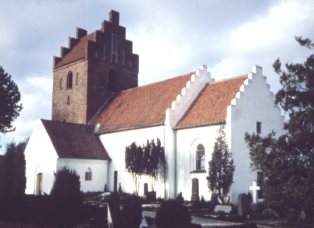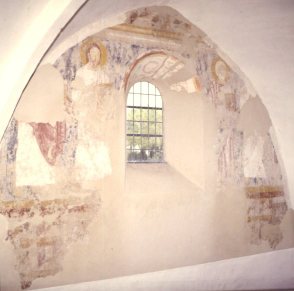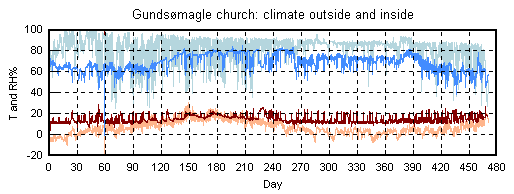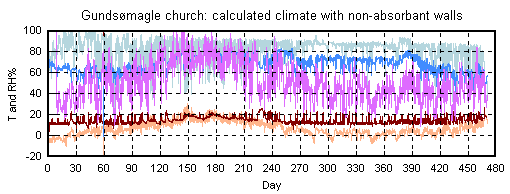
 |
The climate of Gundsoemagle Church |

Gundsømagle Church is a small country church in a village a few kilometres north of Roskilde in Denmark. It was built early in the twelfth century. The walls are mainly of lime tufa, about 40 cm thick, covered with lime plaster on both sides. The brick tower is a later addition. The history of the church is described in reference 1. This article describes the insights gained through a study of the microclimate in the church by Bent Eshøj of the Conservation School in Copenhagen, and myself.

The north wall of the choir is decorated with a wall painting from the 12th century. The paint is stable but friable, and therefore uncleanable without certain loss of paint or alternatively a loss of visual and historic authenticity through the use of a consolidant. This painting is very unusual in that it has not been restored since the mid fifteenth century, when some minor repairs were made after damage caused by building the vaults. It was covered with whitewash some time later and uncovered after a fire in 1987. The history of the painting is described in (2)
The climate in the church was measured for a year and a half. The data are given in full in reference 3 and the interpretation is presented in two papers (2,4). In this article I present a brief and informal analysis, emphasising findings and ideas that can be applied generally.

This graph shows the climate of the church interior (bold colours) and also the churchyard climate, measured on the north wall of the church. The record starts at the beginning of March and continues for sixteen months.
Note that many of the graphs in this article can be enlarged by clicking on them. The larger graphs identify all the curves
There seems at first to be nothing unusual to see. The thermostat seems to be set to 12 degrees and the church is further warmed to about 20 degrees when the faithful gather inside and when the organist wants to practice pieces requiring warm fingers. The interior relative humidity falls during the winter, as expected when the cold winter air with its small water content is drawn in and warmed up.
The practice of maintaining a constant low heat for the benefit of the church, which is increased when people come, is a measure to reduce energy consumption in often empty, uninsulated buildings. It is also recommended for the preservation of wooden objects in churches (5). The theory is that the woodwork does not like a low RH but is too slow to react to a RH that suddenly falls and then recovers.
The RH typically drops about ten percentage points when the church is warmed up for human activity. This is not very much and so we made a calculation to check if it accords with theory.

The purple line that has now been added to the climate graph is the expected RH on the assumption that the church is well ventilated and entirely unable to absorb or desorb water vapour. A recalculation based on the measured ventilation rate would smooth out the purple line but would not alter its general course, which is much lower than the measured value for RH.
There must be a hidden source of water vapour to keep the RH well above the expected value in winter. The next section explores the possible sources of water but before moving on I will just mention that this is not a unique property of Gundsømagle church: it is a universal (meaning wherever we have measured) characteristic of churches with porous walls.
References:
1. Henrik Græbe, Birgit Als Hansen and Hans Stiesdal: 'Gundsømagle kirke, en bygningshistorisk undersøgelse' (Gundsømagle church, an investigation of the building history) Nationalmuseets Arbejdsmark (1990) pp 141 - 156, In Danish, illustrated, with an English summary.
2. Tim Padfield, Peder Bøllingtoft, Bent Eshøj, Mads Chr. Christensen, 'The wall paintings of Gundsømagle church, Denmark', Preprints of the IIC conference, Ottawa 1994 pp 94-8.
3. Bent Eshøj, 'Klimaundersøgelser i Gundsømagle Kirke', Det Kongelige Danske Kunstakademi, Konservatorskolen, 1993
4. Bent Eshøj and Tim Padfield 'The use of porous building materials to provide a stable relative humidity', Preprints of the ICOM-CC Conference, Washington DC, 1993, pp 605-9.
5. H. Künzel and D. Holz, "Richtiges Heizen in historisches Gebäuden", (Correct heating of historic buildings) VDI Berichte nr. 896, (1991): 121-137.

This work is licensed under a Creative Commons Attribution-Noncommercial-No Derivative Works 3.0 License.